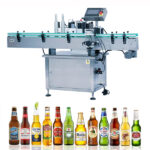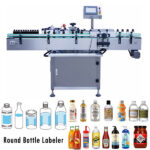Hot filling, as the name implies, is to complete the filling after heating the material, there are usually two general situations that require hot filling: one is the need to increase the liquidity of the material by heating to facilitate filling (also called molten filling machine), common materials are: candles, deodorant, CBD oil, car wax, polishes, lip balms, glycerin products and petroleum based products; the other is to sterilize the material by heating it so that it can be stored and transported with a long time, common materials are: juices, nectars, flavored waters, marinades, teas, soups, spreads etc.
Hot filling for fluidity
Some products require a temperature change to accomplish consistent and reliable fills, or to simply enable the fill. For example, some molten products will be sold as a solid, but must be melted to accomplish the fill in the first place, such as many candle products. How the viscosity change is achieved will depend in part on the types of products running through the machine.
The first and simplest way to complete a hot fill is to heat the tank. A heated tank allows product to reach a temperature at which the product will flow freely through the product pathway and nozzles in to the waiting bottles or other containers. For some products, the heated tank will keep the viscosity low enough to complete the fill. Once filled, a packager may use a power cooling conveyor, with or without the assistance of cooling fans, to allow both product and package to cool before moving to the next packaging phase, which is typically capping and sealing. However, some products will cool or solidify rapidly once leaving the tank, which will require a little more than just a heated tank.
Returning to the candle example above, wax type products have a tendency to cool rapidly when removed from heat. The issue created is that product may solidify and clog the product pathway. That is, once the molten product leaves the tank, it may cool or solidify in a manifold, tubing or even in the nozzles. The solution, then, seems fairly obvious. In addition to the tank, the entire product pathway must be kept heated to achieve the desired fill. This can be done in different ways depending on the filler, the product and other components being used. Product now remains at a constant temperature and viscosity from the tank to the containers, and again a cooling conveyor is likely to be employed to allow the hot liquid to cool or settle.
Heating Test Video
Hot filling for sterilization
During the hot fill process, the liquid is heated up to 194 degrees in order to sterilize the product before it is filled into the container. After the filling process, the container is immediately cooled, which is an extremely important part in preserving the product and taste. Products that are hot filled can last from 6 to 12 months Hot fill is inexpensive and works great with non-carbonated beverage and liquid food products such as fruit and vegetable juices, soft drinks, water and teas.
How Hot Filling Technology Works
Hot filling can be done with glass or some plastics. A liquid is heated to a temperature of 194 degrees Fahrenheit to remove any harmful bacteria or microorganisms which may be in the product. The heated fluid is then put into the bottle, the bottle is capped, and then it is turned on its side or upside down to ensure the cap is sterilized properly as well. Finally, the bottle and product are rapidly cooled. This process must be done carefully as even a slight drop in temperature before the right time can result in improper sterilization and an unsafe product.
What Kind of Bottles to Use
While glass bottles have traditionally been used for hot filling, PET bottles can withstand the heat involved with hot filling without collapsing or becoming deformed. These bottles are growing in popularity because plastic is generally less expensive than glass.
The benefits of hot filling packaging
When you control the microbiological part of the hot fill packaging, you can realize cost savings in your manufacturing. Hot filling is far more economical and a simpler process when compared to aseptic technology. If you have considered aseptic packaging technology, you will find that you'll need a much larger capital investment.
Hot fill packaging provides a wide range of benefits. Among them are:
- Hot fill packaging is a proven technology.
- You benefit from greater customer satisfaction.
- Consumers can consistently trust the safety of your product
- Your products have a longer shelf life
- No preservatives will be needed - the product remains as natural as possible
- Taste, vitamins, and nutrients are preserved with this process
- It has provided a billion of liters of time-sensitive beverages.
- The technology is environmentally friendly, helping reduce the amount of greenhouse gases released into the atmosphere.
Hot Filling Process

Hot filling products, just like any other filling project, will require an analysis of many different components to find the best and most efficient solution for getting product from the tank to the containers. VKPAK has the experience to assist with such an analysis and help each packager find the ideal solution for their own unique packaging project.








